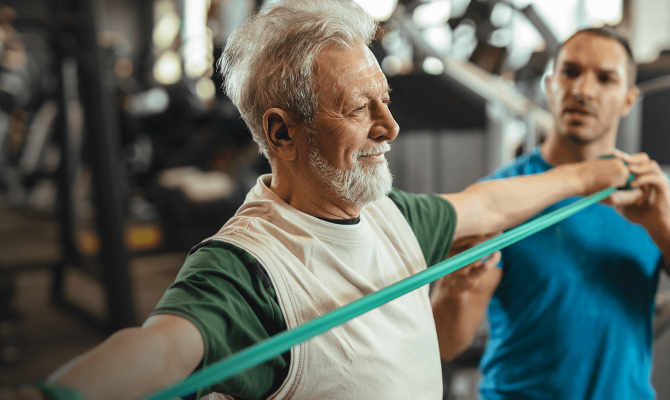Getting Your Daily Dose of 'Deskercise'
19 Jan 2021
19 Jan 2021

2020 was a difficult year for many of us. Having to adapt to a change in work environment and the uncertainties brought about by Covid-19 can be stressful. These emotional stressors can result in physical limitations and pain.
Let’s be honest, many of us may not have been maintaining our usual good habits and this can result in suboptimal functioning. We have had to adapt to a lot of changes such as working from home, a change in jobs, hot desking or home schooling. All of this can add stress on our bodies, both at work and home. These added stressors and loads can lead to headaches, issues with breathing and the digestive system, arm pain (pins and needles and/or numbness) and back pain.
Take a look in the mirror, does your chin protrude more than others? Do your shoulders sit forward or do you find yourself slumping at your desk? Do you often get headaches or neck pain? If you answered ‘yes’ to any of these questions, you may benefit from having a physiotherapy consultation to address issues and assess your posture.
Got a niggle or pain? Book an appointment with a physiotherapist today.
Posture is defined as the relative position or attitude of the body. ‘Neutral posture’ is the position when the joints involved are not overloaded and the spine is in a relaxed position and not twisted. This results in minimal stress being applied to your joints. Many painful conditions of the spine and extremities can originate in areas of high stress, often precipitated by suboptimal postures and musculoskeletal imbalances.
Examples of suboptimal postures include forward head positioning, rounded shoulders, increased mid-back curve (slumped) and loss of the normal curve in the lower back.
The body is very good at adapting to new loads and stresses. However, ongoing abnormal loads can result in pain, changes to flexibility, muscle imbalance and discomfort over time.
Leaning forward while sitting or adopting a slumped position with the head forward and the back curved for an extended period can also have an impact on your breathing, digestive system and result in headaches and/or migraine. Often it is as simple as receiving a few physiotherapy treatments to address muscle length and strength balance, correction of your workplace set-up and performing some simple exercises. This is not difficult and can reduce a lot of load and stressors on the body which will leave you feeling much better. It is best to get minor pain and discomfort seen to early to limit negative impacts on your training or other life activities.
Our physiotherapists can prescribe you specific exercises to get you moving and functioning optimally again.
On your first visit, several aspects will be reviewed by your physiotherapist. Physiotherapists’ specialise in the evaluation and treatment of musculoskeletal dysfunction. They will identify your limitations and structure an appropriate rehabilitation programme to resolve these. The two main areas are joint mobility and muscle function.
Joint mobility is extremely important. It is not enough to just look at how you move, a physiotherapist will assess each joint level to identify specific restrictions in your movement pattern. Restrictions in movement come from sustained posture over a period of time. A good example of this is runners and cyclists who often have imbalances through the neck and may present with suboptimal posture. This is normally amplified if the athlete does not undertake cross-training in the form of strength and flexibility training. Gym-based strength and mobility focus is required, ideally with a physiotherapist or personal trainer, to ensure that correct technique is maintained.
Muscle function is equally important. There are both superficial and deep muscles in the front of your neck. These muscles control what is happening with your posture. The superficial muscles have no direct attachment to the vertebrae and therefore cannot directly act on specific levels of the neck. Often in instances of neck pain, the superficial muscles will be much more active than the deeper stabilising muscles. The muscles at the back of the head also shorten and become disproportionately strong, resulting in the forward head posture. This is seen with many neck injuries whether from whiplash (e.g. motor vehicle accident) or slow onset neck pain.
Posture and movement are important in all aspects of life. Think about what you are doing in your training and day-to-day activities. You will need to bring these principles into everyday life to establish an adequate endurance to the postural muscles and reduce the risk of injury.
With the appropriate treatment, improvement in posture is relatively easy and beneficial to all. If you have symptoms or want to improve your posture, book a physiotherapist for an assessment. It may be one of your best investments this year.
 | Aaron Searle is a Lead Physiotherapist at Habit Health Wellington |